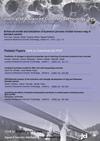土木工程中太赫兹波成像评估纤维增强水泥基复合材料(FRCC)的自愈性
IF 2
4区 工程技术
Q3 CONSTRUCTION & BUILDING TECHNOLOGY
引用次数: 1
摘要
尽管许多研究已经证明了混凝土自愈技术的有效性,但其实际应用仅限于少数试验。其中一个原因是缺乏自我修复的原位无损评估方法,而不是侵入性和广泛的实验室检测。在这项研究中,提出了一种新的太赫兹(THz)波成像技术,作为一种简单,非破坏性和非接触的测量方法来定量评估胶凝材料的自愈效果。在纤维增强胶凝复合材料(FRCC)中进行了实验,通过使用补充胶凝材料(FRCC)和PVA纤维,证实了基于受激自愈合和自主愈合相结合的自修复性能;采用新型太赫兹波测量方法计算了自愈指数,并对现有评价方法进行了比较。同时,按照常规方法对损伤和愈合后的试样进行了吸附性能测试和显微组织表征。因此,所提出的太赫兹成像成功地量化了胶凝样品的自愈性能。此外,还定义了吸附率测试测量的恢复速率(裂纹/愈合)与太赫兹波成像之间的相关性。本文章由计算机程序翻译,如有差异,请以英文原文为准。
Terahertz (THz) Wave Imaging in Civil Engineering to Assess Self-Healing of Fiber-Reinforced Cementitious Composites (FRCC)
Although numerous studies have proven the effectiveness of self-healing technologies in concrete, its practical application is limited to only few trials. One of the reasons lies in the lack of self-healing in-situ non-destructive evaluation methods as opposed to invasive and extensive laboratory testing. In this study, a novel Terahertz (THz) wave imaging technique is proposed as a simple, non-destructive, and non-contact measurement methodology to quantitatively evaluate the self-healing effectiveness of cementitious materials. Experiments were conducted in fiber-reinforced cementitious composites (FRCC), which confirmed self-healing performance based on a combination of stimulated autogenous and autonomous healing by using supplementary cementitious materials (FRCC), and PVA fibers; the self-healing index was also calculated by using novel THz wave measurement and compared with existing evaluation methods. Simultaneously, sorptivity test and microstructural characterization on damaged and healed specimens were conducted as the conventional methods. As a result, the proposed THz imaging successfully quantified the self-healing performance on cementitious samples. Also, a correlation between the recovery rate (cracked/healed) measured by sorptivity test and THz wave imaging was defined.
求助全文
通过发布文献求助,成功后即可免费获取论文全文。
去求助
来源期刊

Journal of Advanced Concrete Technology
工程技术-材料科学:综合
CiteScore
3.70
自引率
10.00%
发文量
45
审稿时长
3.5 months
期刊介绍:
JACT is fast. Only 5 to 7 months from submission to publishing thanks to electronic file exchange between you, the reviewers and the editors.
JACT is high quality. Peer-reviewed by internationally renowned experts who return review comments to ensure the highest possible quality.
JACT is transparent. The status of your manuscript from submission to publishing can be viewed on our website, greatly reducing the frustration of being kept in the dark, possibly for over a year in the case of some journals.
JACT is cost-effective. Submission and subscription are free of charge . Full-text PDF files are available for the authors to open at their web sites.
Scope:
*Materials:
-Material properties
-Fresh concrete
-Hardened concrete
-High performance concrete
-Development of new materials
-Fiber reinforcement
*Maintenance and Rehabilitation:
-Durability and repair
-Strengthening/Rehabilitation
-LCC for concrete structures
-Environmant conscious materials
*Structures:
-Design and construction of RC and PC Structures
-Seismic design
-Safety against environmental disasters
-Failure mechanism and non-linear analysis/modeling
-Composite and mixed structures
*Other:
-Monitoring
-Aesthetics of concrete structures
-Other concrete related topics
 求助内容:
求助内容: 应助结果提醒方式:
应助结果提醒方式:


